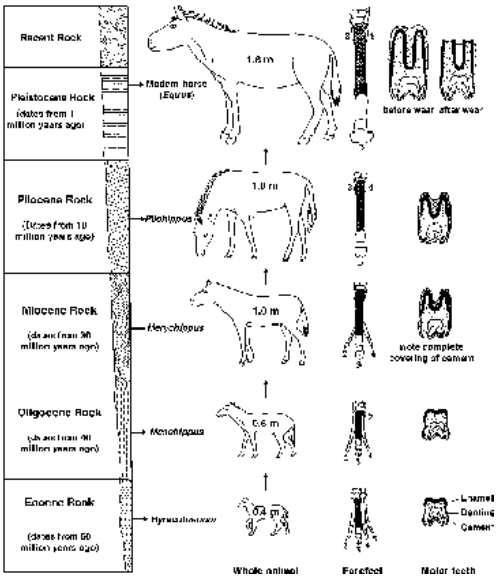Formation of Fossils
Evidences of Evolution of Class 12
Formation of Fossils
It is formed by replacement of organic molecule by inorganic molecule in the dead body. The shape and form of the body is preserved through ages.
Condition for fossilization : The dead body should remain intact (not destroyed or decayed.)
Be burried as such under sand, soil, snow, volcanic lava, oil, or tar, resin or amber (secreted by plants)
Types of fossil on the basis of mode of formation :
- Petrification : Replacement of organic molecules by minerals like iron pyrites, silica, CaCO3 etc; main and the most common way of fossil formation. Hard parts like bone, teeth, shell (mollusca), cuticle and tree trunk (coal fossils) get fossilized this way as these already contain minerals.
- Preservation : When a dead or living body get suddenly embedded within liquid that soon becomes solid. Body remains intact at tissue level. The liquids (resin, amber, gum etc) thus acts as preservative, same does the ice e.g. for wooly mammoth of Siberia.
- Mould : If dead body lies within soft or loose material which later becomes hard/solid and later the body part vanishes and its space only is left in the rock as a mark.
- Imprints or impression : On many rocks only imprints of body part e.g. foot print are left. Such rocks are formed from initial semiliquid or loose materials; there is no replacement of molecules,
- Compression : Main tissue part disappears and only the outer tough membranous part remains intact converting into rock; generally in plants.
Palynofossils (Microfossils)
Fossils of planktons, diatoms, unicellular algae (diatoms) and shelled protozoans. (Heliozoans, Radiolarian and Foraminiferans). Their finding in soil sample helps in oil exploration. The earth of that time (precambrian era) is called “diatomaceous earth”
Pseudofossil : Some rocks give look of an organism (fossil) but actually are not fossils.
Coprolite : Fossils of faces burried in sediments.
Age Determination of fossil : Radio active dating is the scientific method introduced by Boltwood (1907)
Carbon dating : Introduced by (W.F. Libby - 1950) : In every 55680 years half of 14C decays to 12N, the age of fossil of only about 70,000 years are well determined by this method.
Uranium - Lead dating : 235U decays to 206Pb in 66 million years.
Potassium - Argon dating : Used for determining the age of older fossils (like hominids) – half life of 40 K is 1.3 × 109 changing into Argon.
Fossil forests :
Preserved and protected areas containing fossils of different ages.
- 50 million years old - Deccan forest in Mandla district of M.P.
- 100 million years old - Raj Mahal forest, Santhal Pargana district of Jharkhand
- 250 million years old - Coal forest of Orissa
- 20 million years old - National fossil park, Tiruvakkarai in South Arcot district, Tamil Nadu.
Mass Extinction :
Since beginning many species evolved and got extinct (in fact only 1% is living) Sometimes it occured suddenly at large scale, (most recently dinosaurs about 60 million years ago) the reason is still a mystry.
High concentration of irridium (rare on the earth) in a thin layer below surface soil (60 million years old) is present in meteorites. This suggests that some comet or meteorites hit the earth around that time. The energy equal to several thousand hydrogen bombs would have been the reason for mass extinction. Alternate hypothesis is global cooling .
Fossil History of Horse : Credit to Prof. Marsh (1879) of Yale University for complete work.

Fig.3.3: Depicting evolution of the horse with related rock strata and changes in digits and teeth.
The ancestor of present horses arose about 5 crore years ago (Eocene epoch) in North America. First was Eohippus (or Hyracotherium) the ‘dawn horse’ (40 cm high like a fox); four complete digits (2,3,4 and 5), first digit as splint bone. Mesophippus, (Oligocene); 60 cm; 1st and 5th digits as splint bone Merychippus (or Miohippus), the ‘ruminating horse’, (Miocene epoch); 100 cm; 3 digits; only middle toe touching the ground Pliohippus (Pleshippus) Pliocene epoch; 120 cm; first ‘one toed horse’ like a modern pony. Equus (Modern horse) Pleistocene epoch; 9-10 lakh year ago; 150 cm; long head and long neck for better perception of enemies; legs more adapted for fast running on hard ground.
- Introduction of Evolution
- Evidences from taxonomy
- Evidence from Connecting Link
- Evidences from physiology and biochemistry
- Formation of Fossils
- Evidences from Biogeographical Distribution
- Evidences from cytology and genetics
- Evidences from Embryology
- Evidence from morphology and comparative anatomy
- Exercise-1
- Exercise-2
- Exercise-3









